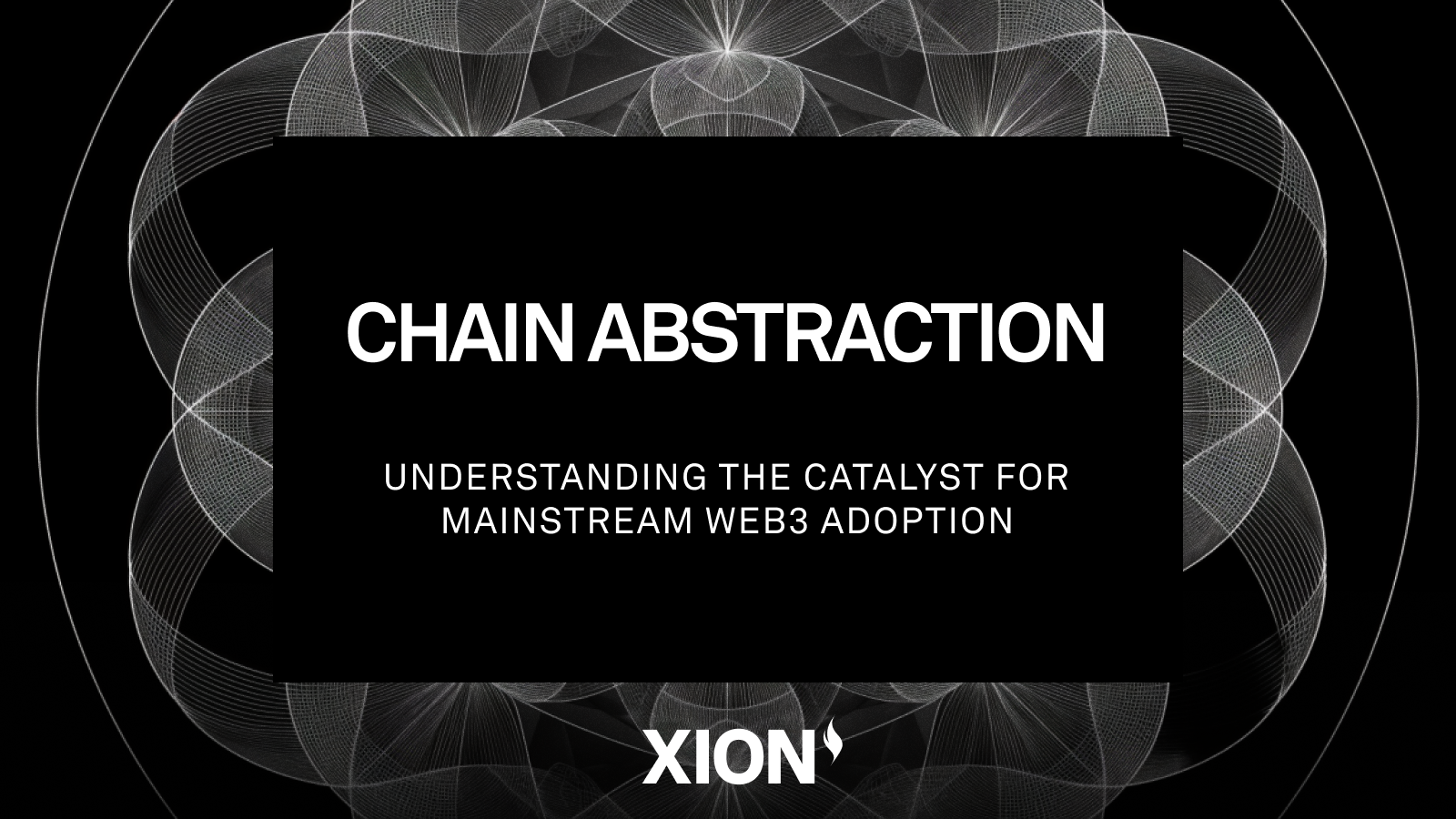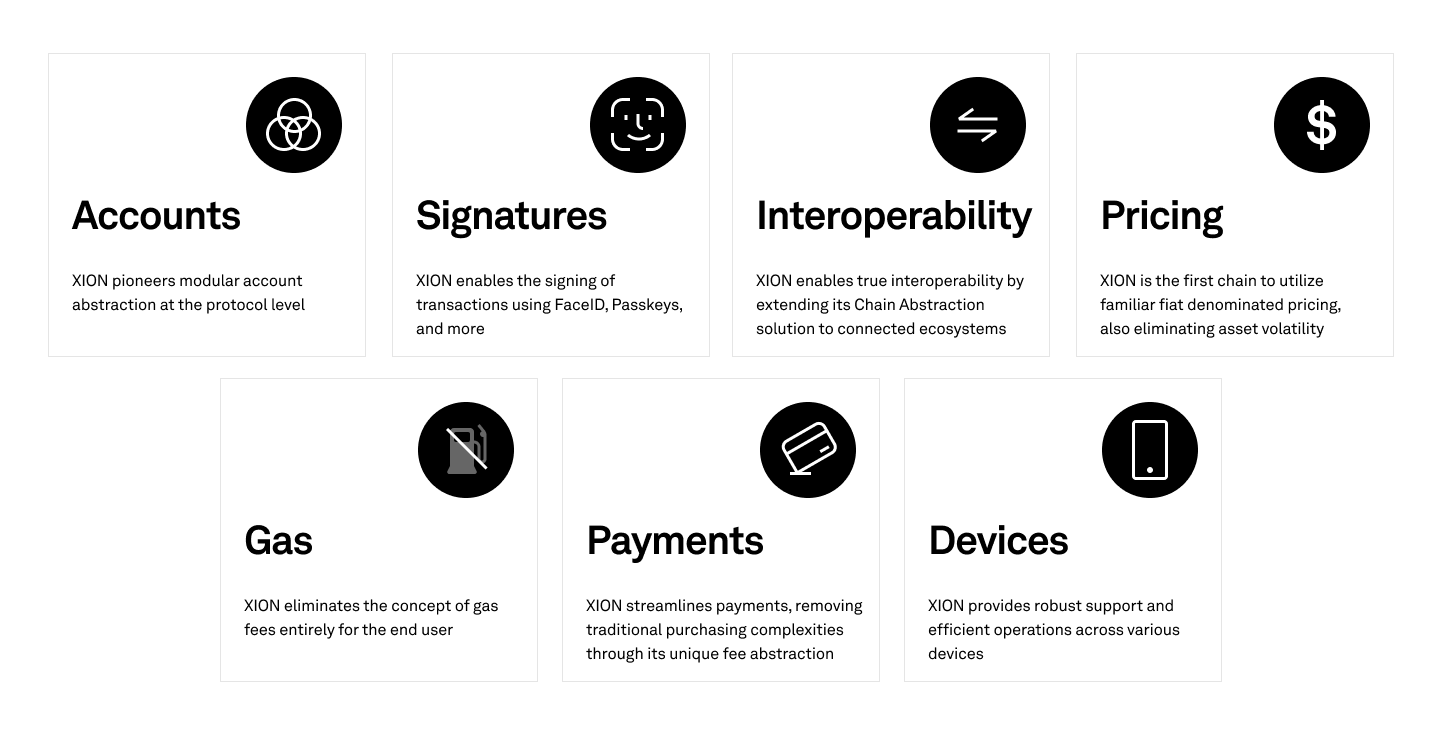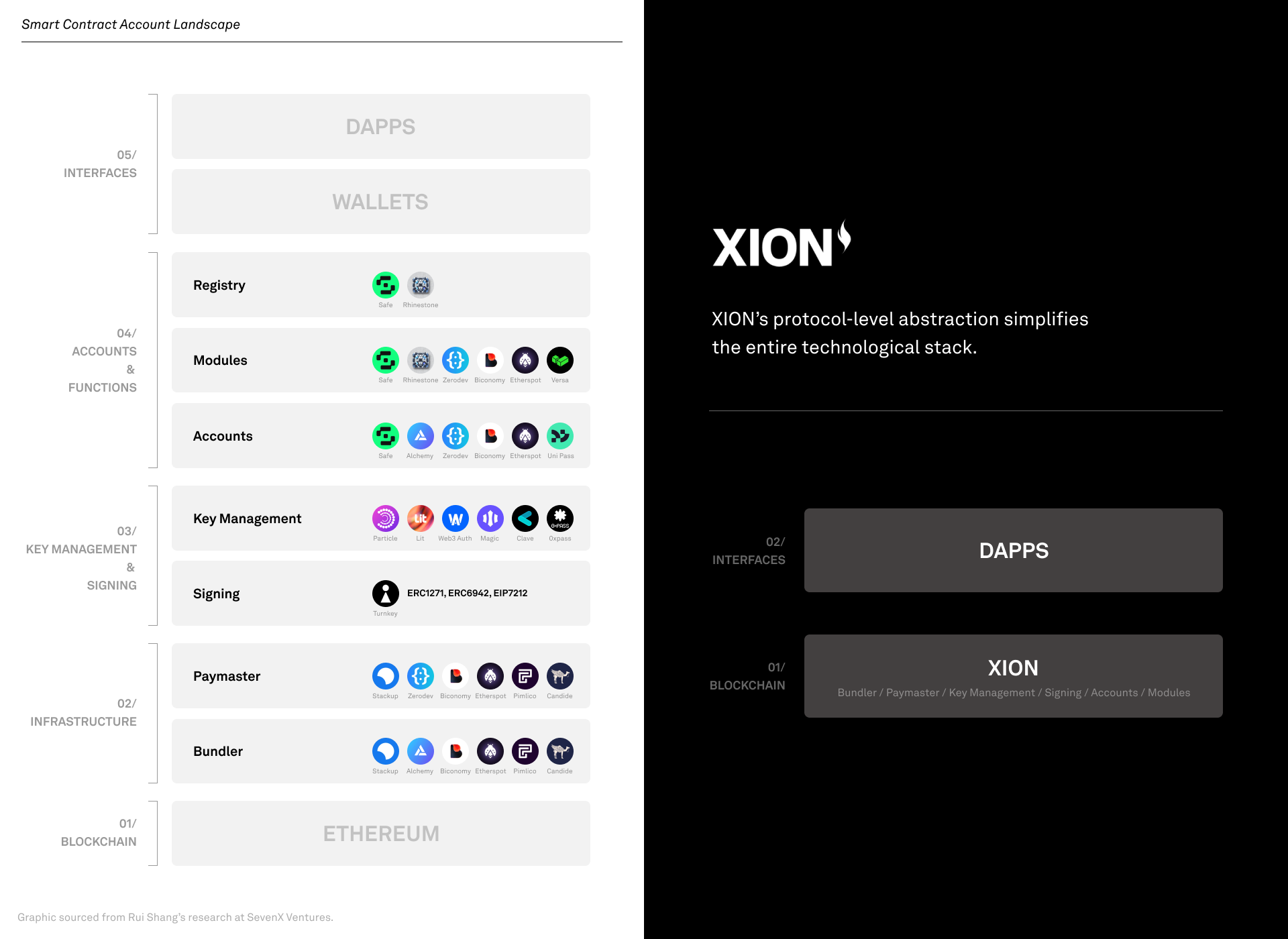
Summary: Chain Abstraction is a term which is becoming increasingly popular but it is poorly defined within the industry. In development, Chain Abstraction is the process of removing complexities and technicalities that interfere with user experiences while maintaining the broader benefits of decentralized technology. In practice, Chain Abstraction should be implemented in a manner whereby the focus is to spur the development and adoption of applications with genuine use cases that appeal to the mainstream market. It should also have the potential to extend to other ecosystems as Web3 evolves into a multi-chain environment. XION is the first layer-1 blockchain purpose-built with Chain Abstraction at its core. Its early adoption and traction have attracted enterprises such as Uber and The North Face to applications built using its infrastructure, highlighting that developed and executed correctly, Chain Abstraction holds the potential to open the gates of the mainstream market to Web3 technology.
Introduction
Web3 aims to provide the decentralization benefits of blockchain technology to the mass market. However, the industry as a whole has failed to provide any semblance of simplified user experiences, leaving only a niche market which is willing to use Web3 applications. These apps have failed to reach the UI/UX standards that are necessary to attract the mainstream market.
While those passionate about blockchain technology may be willing to overcome the learning barriers and hurdles to using Web3, the average person will only use a Web3 app if the complexities inherent in the technology are smoothed out and replaced with a simplified experience. The success of Web2 apps like Instagram, Cash App, and Apple Pay has shown us the importance of clean user interfaces, simple sign-on experiences, and frictionless interactions. These apps have onboarded billions of users, a feat which the crypto industry has yet to accomplish.
The key to Web3 gaining access to the broader mass market is by providing both the benefits of decentralization, such as self-sovereignty and censorship resistance, while also providing familiar user experiences capable of being used by all audiences.
XION’s Chain Abstraction provides this solution.
Defining Chain Abstraction
Chain Abstraction is the process of removing complexities and technicalities that interfere with user experiences while maintaining the broader benefits of decentralized technology.
Web2 didn’t tap into the mass market by expecting users to understand the intricacies of HTTP and TCP/IP. It opened itself to the world when it abstracted away the technical complexities and replaced them with a smooth and intuitive user experience. Similarly, Web3 needs to maintain the self-sovereignty and censorship-resistant features of the underlying technology while abstracting away the complexities and friction for users interacting with Web3 at the interface layer.
Through Chain Abstraction, technical blockchain complexities which materialize on the interface layer as friction points are abstracted away and replaced with easy-to-use UX/UI features such as simple sign-ins and one-click interactions. For instance, activities such as signing up, interacting with smart contracts, managing gas tokens used for transaction fees, and executing payments in different crypto assets are all integrated into a seamless UX which makes it as easy as interacting with your favorite finance or social media app.
From the user’s perspective, Chain Abstraction allows them to easily use applications without understanding or even being aware of the underlying tech components which make it function. The user simply interacts with an interface and through that interface, they can carry out decentralized Web3 functions in a manner which is almost indifferentiable from a Web2-app.
Why is this important? It solves the hurdles to mainstream adoption.
Hurdles to Mainstream Adoption
At its core, the mainstream market hasn’t adopted Web3 technology because the utility to draw the masses to the technology is not there. This utility comes in the form of real products and applications that provide value to the user. The Web2 internet economy flourished when there was a proliferation of online applications and services that provided a tangible and real impact on people’s lives. As it stands, Web3 barely even registers on the radar of the mainstream market when it comes to providing real products with genuine use cases.
Why has the industry struggled to produce these use-cases? There are both functional and cultural barriers which are preventing the development of real products.
Functional Barriers
The functional barriers relate to how the technology is built and structured. The end consumer should not need to understand the technical intricacies of blockchains to use the products which are built on top of these chains. At present, many of these intricacies are present in the end product. The current Web3 user journey is rife with complications and friction leading to extremely high drop-off rates. Below are a few of the major examples:
Wallet Complexities: Traditional crypto wallets are known to create a 95%+ drop-off in user adoption. They require users to download plugins, have complex setups, confusing pop-ups, require users to understand and safely store seed phrases, and their UX in general deters non-technical users.
Lack of Mobile Support: In many ways, mobile support is the way to true retail adoption, especially when recognizing that a significant portion of all digital interactions occur on mobile devices. However, mobile crypto wallets are currently a security risk, don’t translate well between desktop and mobile devices, require users to travel with their seed phrase, and the current UI/UX of in-app browsers is incredibly under-performant.
Purchasing Complexities: The current process of purchasing items on-chain is riddled with challenges often involving 15+ steps and sometimes more than a week to complete. A user must sign up to a centralized exchange, perform KYC, wait for their money to transfer, deal with wallets, bridge the funds, swap to the right currency, and more before being able to purchase.
Gas Fee Friction: A major barrier to adoption for new users is the requirement of gas fees, as it forces them to own the chain’s underlying currency in order to transact. In addition to introducing the foreign concept of gas fees, users are also faced with many of the same challenges mentioned above as they relate to acquiring a certain currency.
Pricing Volatility & Unfamiliarity: Within the industry there are thousands of tokens and it is incredibly confusing for new users to understand their value and subsequently the pricing of products denominated in those tokens. In addition, their incredibly volatile nature deters the ability for sustainable use-cases to thrive.
Fragmentation: There is an ever-growing number of fragmentation issues that span across the infrastructure stack to the end users, and it is only destined to increase through the continued proliferation of new blockchain ecosystems.
Cultural Barriers
In terms of cultural barriers, these hurdles are related to the language and public perception around Web3 technology and its products. The industry needs to transition from intimidating to inviting. To accomplish that not only requires addressing the functional barriers but also controlling the language and narrative around the technology. If it is to break into mainstream awareness, the technology cannot be something which is solely to be discussed by finance and tech enthusiasts. Complex topics need to be communicated in a way that abstracts away their complications and markets their use cases and impact on the lives of real people. Users shouldn’t need to understand or care about the underlying infrastructure, they should simply be able to use products that bring them value.
Creating the right infrastructure is only one piece of the puzzle that addresses the functional barriers. Showcasing the technology in a way where people can easily recognize its impact and value will help those who are hesitant to embrace and experiment with it.
XION’s all-encompassing Chain Abstraction solution addresses both the functional and cultural barriers critical to reaching mass adoption.
XION's Chain Abstraction Solution
XION is a layer-1 blockchain purpose-built to abstract away the complexities of Web3 technology. It was developed with Chain Abstraction at its core, with every element of its infrastructure designed to address the functional & cultural barriers prevalent in Web3 technology. As a result, XION is the first blockchain to enable versatile products and applications to flourish among non crypto-native audiences.
How does it achieve this through Chain Abstraction?
XION employs an all-encompassing solution for Chain Abstraction to be effective in solving adoption challenges. As detailed above, there are a myriad of complexities and technicalities in the current Web3 ecosystem that need to be abstracted away. Incremental solutions – such as adding the ability for a user to login with their email – might simplify one step of the user onboarding process, but if the user is then met with 15 additional steps to understand and manage gas fees, acquire tokens, grasp the inherent value of those tokens, and more, then the initial simplicity becomes moot.
The robustness of XION’s all-encompassing Chain Abstraction solution is highlighted below through multiple distinct facets, each addressing specific pain points. In addition, through its modular design, XION is designed to enable many more future extensions.
Account Abstraction: XION pioneers modular account abstraction at the protocol level.
The solution to many of the traditional wallet complexities can be solved through XION’s Meta Accounts – powerful smart contract accounts. Not only do they allow familiar login methods such as email for users, but they also unlock other security enhancements like account recovery, account permissioning, and much more. In addition, XION’s Meta Accounts remain invisible to the rest of the protocol. This design, subtle yet impactful, ensures that developers can focus on creating value without needing to make any special considerations for these accounts.
Signature Abstraction: XION is the first chain to support signing across all current and future cryptographic curves, through complete Signature Abstraction.
This breakthrough means XION enables the signing of transactions using Apple’s FaceID, Passkeys, JWTs, EVM curve, Solana curve, and beyond. Moreover, given XION’s modular approach, it's primed for extending support to many more signature schemes as new ones emerge, rendering XION ‘future-proof’. Also, when utilizing non-wallet authenticators like Passkeys, NFCs, ZKs, and the likes, no trusted proxies or oracles are needed since communication occurs directly against the chain. This not only heightens security but also aligns with the Web3 ethos of trustlessness.
Gas Abstraction: XION completely removes the concept of gas fees from the end user’s perspective.
Gas fees have been one of Web3’s biggest hurdles for new users. Besides introducing an unfamiliar concept to new users, the process of acquiring the necessary gas tokens is a major barrier to entry in most ecosystems. This turns out to be a significant barrier for users and XION entirely eradicates it by leveraging its protocol-level abstractions and built-in paymasters.
Payment Abstraction: XION streamlines payments by eradicating the traditional purchasing complexities through its unique fee abstraction.
Traditionally, the process of purchasing items on-chain as a new user often involves 15+ steps and sometimes extending over a week to complete. A user must endure the ordeal of signing up to a centralized exchange, performing KYC, waiting for their money to transfer, dealing with wallets, bridging the funds, swapping to the correct currency, and more before making a purchase. Through its parameterized fee layer, XION enables the use of any token for transacting.
Device Abstraction: XION fully abstracts away the concept of wallet plugins or apps, enabling users to access their XION accounts in myriad ways—whether by email, FaceID, Passkeys, or other methods — providing robust support and efficient operations across various devices.
As mentioned above, mobile is the gateway to true retail adoption. XION’s infrastructure ensures ease of access to accounts from any device. Moreover, it allows the separation of login from assets, creating a safe avenue for users to interact with new apps without putting their assets at risk. In essence, it permits users to access XION’s ecosystem anytime, anywhere, safely.
Pricing Abstraction: XION is the first chain to utilize familiar fiat-denominated pricing throughout the chain, made possible by combining multiple facets of its abstraction.
This innovation has many benefits related to security, stability, and familiarity. Given USDC is native to the ecosystem, users don’t have to worry about bridging risks. In addition, fiat-denominated assets eliminate price volatility, enabling many consumer-facing use-cases not previously possible. Lastly, it enables all assets on XION to be denominated in familiar currency to everyday users.
Abstracted Interoperability: XION is able to extend its Chain Abstraction solution to enable true interoperability across ecosystems.
Especially in an industry flush with different chains and tokens, it’s pivotal to reduce fragmentation by providing users with a unified user experience. By extending its Chain Abstraction solution cross-chain, XION enables seamless composability of users, apps, and liquidity across connected ecosystems. XION’s solution allows it to serve as an extension to all major blockchain networks, reshaping the historically competitive nature of L1s, which typically compete for users, liquidity, and developers, to enable true mainstream adoption. This has a variety of benefits across all audiences:
For Users = Unified User Experience
Mainstream users onboarded through XION's streamlined products can seamlessly interact with applications across diverse ecosystems. By abstracting blockchain complexities, XION perpetuates the industry adoption flywheel effect, enhancing user engagement and retention.
For Developers = No Developer Siloing
Developers leveraging XION's platform benefit from its advanced infrastructure without the constraints of ecosystem siloing. Through Chain Abstraction, they can easily access users and liquidity across major connected ecosystems, expanding their reach and potential for innovation.
For Connected Ecosystems = User Pipeline
XION facilitates a seamless pipeline of mainstream users to interconnected ecosystems. By offering intuitive products and a robust chain abstraction solution, XION enables users of all technical backgrounds to effortlessly engage with applications across various ecosystems. XION Meta Accounts provide a unified experience, eliminating the need for traditional wallets, seed phrases, plugins, and more, while ensuring seamless cross-device compatibility.
For the Industry = Innovation
XION enables unprecedented cross-ecosystem app composability. Applications on different chains can interact, allowing users to initiate actions on one platform based on their interactions on another. This interoperability fosters new use cases, driving innovation across all connected ecosystems.

XION’s all-encompassing Chain Abstraction solution spans Accounts, Signatures, Gas, Pricing, Devices, Payments, and Interoperability. By abstracting away the myriad of complexities and friction points associated with Web3, XION serves the purpose of making Web3 applications intuitive to use. In addition, it also serves the purpose of making it easier for developers to launch mainstream-ready applications. This creates a cyclical effect of incentivizing both development and adoption waves, with each wave creating greater demand for the other. More mainstream users entering Web3 spurs greater development and product launches, which in turn attracts a greater market and so forth.
A key element in facilitating this cyclical effect is XION’s simplified tech stack.
XION’s Simplified Developer Stack
With protocol-level abstractions built in, XION’s tech stack is vastly simplified to facilitate streamlined development. This allows for greater product development and quicker iterations on existing applications. XION’s simplified developer stack not only streamlines development but also allows for greater support and upgradeability. This is evident when compared to other ecosystems where several layers involving 4+ different entities make upgradeability, coordination, security, and providing support extremely difficult.
Developers can start building using XION's Chain Abstraction solution today by following the Get Started Guide.

Traction Validating XION's Approach
At its core, Chain Abstraction should facilitate both the development and adoption of products and applications with versatile and impactful use cases. XION's substantial traction to date clearly demonstrates that it is facilitating such development and adoption. Over 2.5 million users are actively utilizing products built on the XION chain, reflecting its user-friendly design and widespread appeal. The ecosystem has experienced explosive growth as well, with over 150+ integrations, deployments, and partnerships. With such strong early traction, XION showcases that both the goal and development of Chain Abstraction should be geared towards creating an environment where both Web3 development and adoption can flourish.
A prime example of XION's impact is the successful launch of EarnOS, an application designed to help companies build, engage, and reward their customer base. EarnOS has successfully onboarded major brands like Uber, Baskin Robbins, Sunglass Hut, and The North Face, highlighting the novel use cases enabled by Chain Abstraction and their accessibility to the broader mainstream market (read more about the pivotal launch here).
In addition, XION has been rapidly expanding its Chain Abstraction solutions to other major blockchains, including Solana, BNB, Injective, AVAX, and more, becoming the first truly collaborative layer-1 blockchain. This expansion facilitates a unified user experience across different ecosystems, further driving innovation and adoption in the industry.
XION's Chain Abstraction represents a paradigm shift for the industry as it paves the way for true mainstream adoption of Web3. By seamlessly bridging the gap between complex blockchain infrastructure and user-friendly experiences, XION is solving current adoption hurdles and laying the foundation for a future where decentralized technologies are as accessible and intuitive as today's most popular Web2 applications. With major brands already on board and millions of users engaged, XION is proving that when executed correctly, Chain Abstraction has the power to unlock the full potential of Web3.
ABOUT BURNT
Burnt is a core contributor to XION, the first layer one purpose-built for consumer adoption through chain abstraction. Utilizing protocol-level implementations related to abstracted accounts, signatures, fees, interoperability, and more, XION enables secure, intuitive, and seamless user experiences. Burnt believes everyone, regardless of technical knowledge, should be able to have the same access to true ownership. The project has raised over $36M from top-tier investors including Animoca, Circle, Multicoin, Arrington Capital, Spartan, and more.